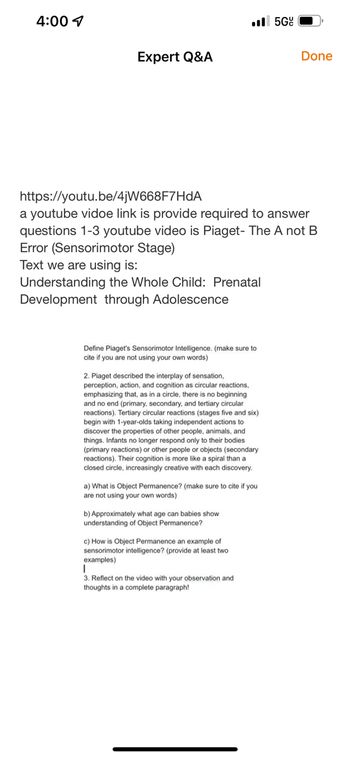
Ciccarelli: Psychology_5 (5th Edition)
5th Edition
ISBN: 9780134477961
Author: Saundra K. Ciccarelli, J. Noland White
Publisher: PEARSON
expand_more
expand_more
format_list_bulleted
Question
thumb_up100%

Transcribed Image Text:4:00 ✓
Expert Q&A
https://youtu.be/4jW668F7HdA
a youtube vidoe link is provide required to answer
questions 1-3 youtube video is Piaget- The A not B
Error (Sensorimotor Stage)
Text we are using is:
Understanding the Whole Child: Prenatal
Development through Adolescence
.5G
Define Piaget's Sensorimotor Intelligence. (make sure to
cite if you are not using your own words)
2. Piaget described the interplay of sensation,
perception, action, and cognition as circular reactions,
emphasizing that, as in a circle, there is no beginning
and no end (primary, secondary, and tertiary circular
reactions). Tertiary circular reactions (stages five and six)
begin with 1-year-olds taking independent actions to
discover the properties of other people, animals, and
things. Infants no longer respond only to their bodies
(primary reactions) or other people or objects (secondary
reactions). Their cognition is more like a spiral than a
closed circle, increasingly creative with each discovery.
a) What is Object Permanence? (make sure to cite if you
are not using your own words)
b) Approximately what age can babies show
understanding of Object Permanence?
c) How is Object Permanence an example of
sensorimotor intelligence? (provide at least two
examples)
I
3. Reflect on the video with your observation and
thoughts in a complete paragraph!
Done
Expert Solution
This question has been solved!
Explore an expertly crafted, step-by-step solution for a thorough understanding of key concepts.
Step by stepSolved in 2 steps

Knowledge Booster
Recommended textbooks for you
 Ciccarelli: Psychology_5 (5th Edition)PsychologyISBN:9780134477961Author:Saundra K. Ciccarelli, J. Noland WhitePublisher:PEARSON
Ciccarelli: Psychology_5 (5th Edition)PsychologyISBN:9780134477961Author:Saundra K. Ciccarelli, J. Noland WhitePublisher:PEARSON Cognitive PsychologyPsychologyISBN:9781337408271Author:Goldstein, E. Bruce.Publisher:Cengage Learning,
Cognitive PsychologyPsychologyISBN:9781337408271Author:Goldstein, E. Bruce.Publisher:Cengage Learning, Introduction to Psychology: Gateways to Mind and ...PsychologyISBN:9781337565691Author:Dennis Coon, John O. Mitterer, Tanya S. MartiniPublisher:Cengage Learning
Introduction to Psychology: Gateways to Mind and ...PsychologyISBN:9781337565691Author:Dennis Coon, John O. Mitterer, Tanya S. MartiniPublisher:Cengage Learning Psychology in Your Life (Second Edition)PsychologyISBN:9780393265156Author:Sarah Grison, Michael GazzanigaPublisher:W. W. Norton & Company
Psychology in Your Life (Second Edition)PsychologyISBN:9780393265156Author:Sarah Grison, Michael GazzanigaPublisher:W. W. Norton & Company Cognitive Psychology: Connecting Mind, Research a...PsychologyISBN:9781285763880Author:E. Bruce GoldsteinPublisher:Cengage Learning
Cognitive Psychology: Connecting Mind, Research a...PsychologyISBN:9781285763880Author:E. Bruce GoldsteinPublisher:Cengage Learning Theories of Personality (MindTap Course List)PsychologyISBN:9781305652958Author:Duane P. Schultz, Sydney Ellen SchultzPublisher:Cengage Learning
Theories of Personality (MindTap Course List)PsychologyISBN:9781305652958Author:Duane P. Schultz, Sydney Ellen SchultzPublisher:Cengage Learning

Ciccarelli: Psychology_5 (5th Edition)
Psychology
ISBN:9780134477961
Author:Saundra K. Ciccarelli, J. Noland White
Publisher:PEARSON

Cognitive Psychology
Psychology
ISBN:9781337408271
Author:Goldstein, E. Bruce.
Publisher:Cengage Learning,

Introduction to Psychology: Gateways to Mind and ...
Psychology
ISBN:9781337565691
Author:Dennis Coon, John O. Mitterer, Tanya S. Martini
Publisher:Cengage Learning

Psychology in Your Life (Second Edition)
Psychology
ISBN:9780393265156
Author:Sarah Grison, Michael Gazzaniga
Publisher:W. W. Norton & Company

Cognitive Psychology: Connecting Mind, Research a...
Psychology
ISBN:9781285763880
Author:E. Bruce Goldstein
Publisher:Cengage Learning

Theories of Personality (MindTap Course List)
Psychology
ISBN:9781305652958
Author:Duane P. Schultz, Sydney Ellen Schultz
Publisher:Cengage Learning